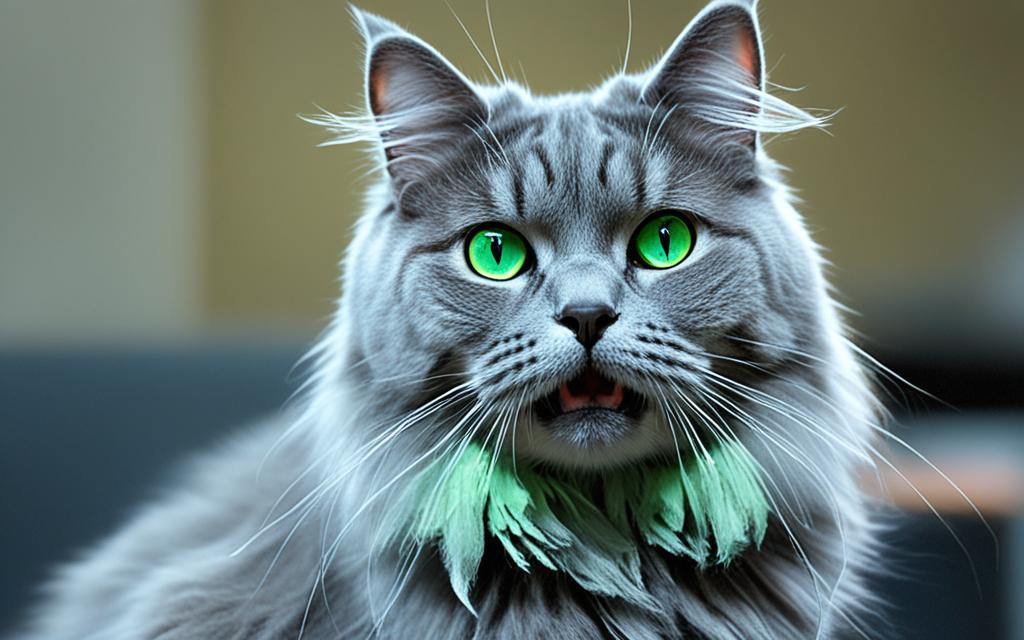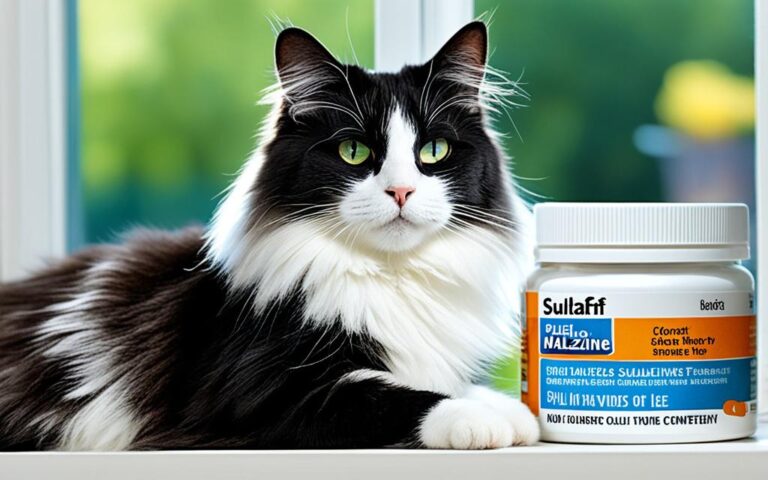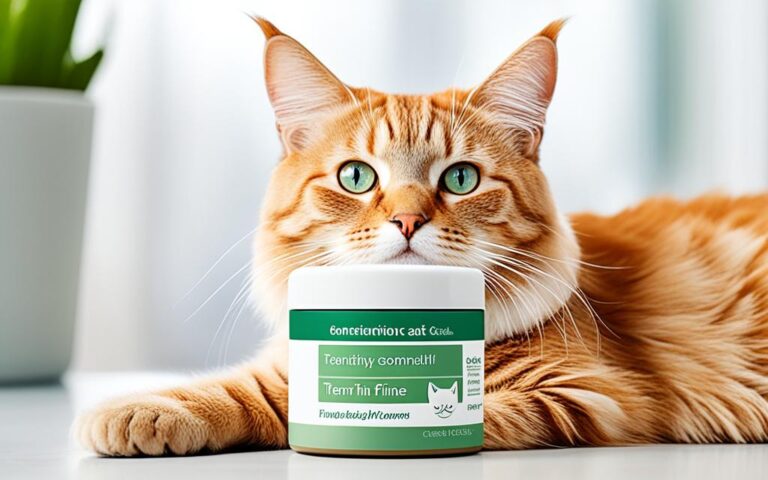Melphalan for cats: Uses and Side Effects
Melphalan is a strong chemo drug that’s helping treat cancer in cats. Yes, you read that right1. It’s used for bone marrow cancer, resistant leukemia, relapsed lymphoma, osteosarcoma, and more. This shows how our pets are benefiting from human medicine tailored by vets.
Key Takeaways
- Melphalan is a chemotherapy drug used to treat certain cancers in cats, including multiple myeloma, leukemia, lymphoma, and more.
- Melphalan can be given by mouth or into a vein but isn’t FDA-okayed for pets.
- This drug is in the alkylating agents which demand close watch over the cat’s health during use.
- Side effects may include low blood counts, bone marrow problems, and tummy troubles.
- Storing and handling melphalan correctly is key for your cat’s safety and treatment success.
Table of Contents
Introduction to Melphalan
Melphalan is a chemotherapy medicine in the group of alkylating agents2. These drugs are strong; they block cancer cells from making new DNA and RNA2. Because of this, melphalan treats cancers like multiple myeloma, leukemia, and others in cats3.
What is Melphalan?
Melphalan fights cancer, specifically some types in humans2. It was created during World War II to kill tumors2. This drug can harm cells that make new ones, however, it doesn’t harm fish and aquatic life2.
Melphalan: A Chemotherapy Drug for Cats
Melphalan is mainly for blood cancers and certain tumors, but less often for multiple myeloma2. It’s not very good with water, but acid can make it last longer2. Mostly, it affects the bone marrow, causing issues like a drop in blood counts and stomach problems2.
Doctors use Melphalan by mouth a lot for treatment of multiple myeloma and lymphoma2. It often causes low blood platelets2. The usual dose is 0.1 mg/kg per day by mouth, but this can change based on the patient2.
This medicine is listed by WHO as a cytotoxic medicine, meaning it’s toxic to cells2. It does this by damaging DNA, which stops cancer cells from growing more2. It can work on cancer cells at different times in their growth2.
One big problem with melphalan is that sometimes cancer cells figure out how to resist it, leading to the cancer coming back. But research keeps going to make it better at fighting cancer. For example, scientists are changing how it’s made to see if it can work better or have fewer side effects2.
Doctors use Melphalan for managing plasma cell myeloma in people and cats2. It’s been thought to help horses with the same disease, but we know very little because those cases are rare2.
Melphalan Uses for Cats
Melphalan is a chemotherapy drug mostly for human cancer. But it’s also used by veterinarians for cats, even though the FDA has not approved it for animals. Vets can prescribe it if they believe it’s a good option for a cat.
Cancers Treated with Melphalan in Cats
This drug helps with several cat cancers like bone marrow cancer (multiple myeloma), leukemia, lymphoma, and others4. Cats get multiple myeloma less often than dogs. But when they do, it’s usually one of two types. One type, IgG, is more common than the other, IgA.
Drugs like Melphalan help a lot4.
Off-Label Use of Melphalan in Veterinary Medicine
Vets use Melphalan off-label to treat cat cancer when they think it’s the right choice. Research shows it works well, with high response rates. But it can be toxic, leading to many cats stopping the treatment5.
To use Melphalan for cats, vets must think hard about it. They need to look at both the good and bad sides. It’s crucial to watch the cat closely and give care as needed6.
How Melphalan Works
Melphalan is a type of chemotherapy for cats. It falls under the group of medicines called alkylating agents7. These drugs interact with the DNA and RNA of cancer cells. They stop these cells from dividing quickly and making more cells7. Yet, Melphalan also impacts healthy cells that are dividing, like those in the bone marrow. This can lead to low blood cell counts and a higher chance of getting sick7.
Mechanism of Action: Alkylating Agent
Melphalan works throughout the cell cycle. It is effective even when cells aren’t growing. This unique characteristic lets it mess up the division and growth of cancer cells. As a result, the cancer cells die out7.
Effects on Cancer Cells and Normal Cells
Melphalan is great at killing cancer cells. But, it also impacts normal, growing cells, like those in the bone marrow7. This may cause issues like low blood cell counts and a higher risk of infection for cats on Melphalan7. Vets watch their patients closely for these problems. They might change how much Melphalan they give or how often they administer it7.
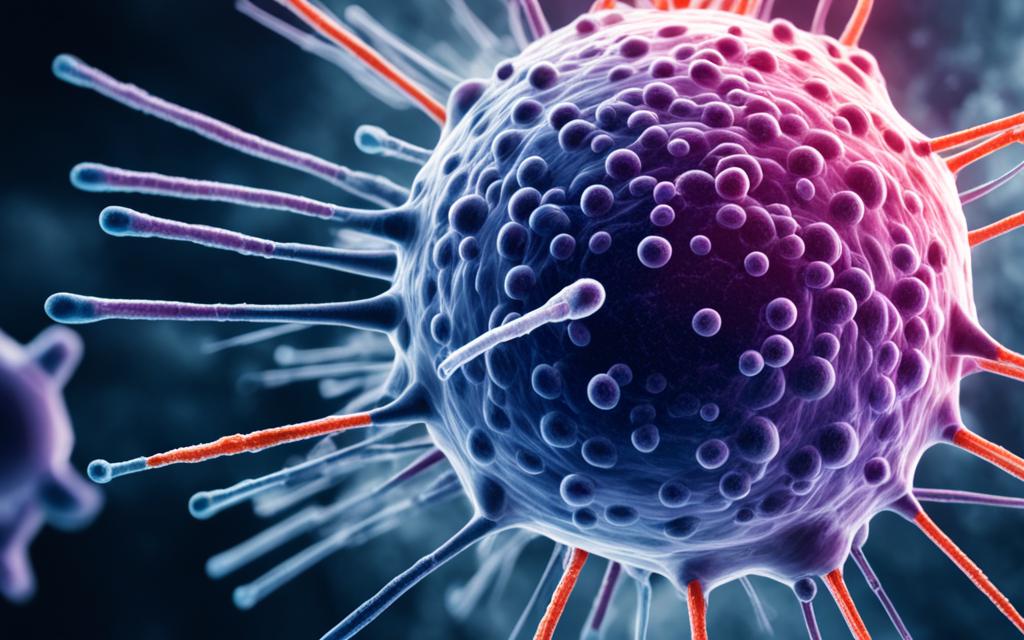
“Melphalan is an effective chemotherapy agent, but it’s important to carefully balance its benefits and risks for each feline patient. Veterinarians must closely monitor their patients to ensure the best possible outcome.”
Knowing how Melphalan works on both cancer and normal cells is key for vets. It helps them decide the best way to use this drug in cat treatment7.
Melphalan Administration for Cats
Melphalan is a type of chemotherapy for cats. It’s often given to cats that are 8-9 years old, especially if they are German Shepherd Dogs, too8. When cats get this treatment, they might seem tired, not interested in eating, and lose weight8.
This medication can be taken by mouth or through a vein at the vet’s office. It’s best to give Melphalan to cats when their stomach is empty or well after they’ve eaten. This helps the medicine work better in their bodies8. Your vet will figure out how much and how often your cat should take Melphalan, depending on the cancer type and the cat’s health.
For dogs, a combination of Melphalan and prednisolone works pretty well, with a good response from 92% of them. This includes both full and partial recovery, with a common survival time of 540 days8. However, cats don’t respond as well to Melphalan. They tend to live about 137 days after starting the treatment8. This shows that the effect of Melphalan isn’t the same for dogs and cats.
Cats with multiple myeloma don’t often have bone issues like dogs do. And they’re not as likely to have kidney or calcium problems as dogs8. This makes the disease a bit different in cats compared to dogs.
Using Melphalan in cats needs extra care and the right amount of it, which only a vet should decide. This way, the treatment is more likely to help the cat896.
Melphalan Dosage and Frequency
Veterinarians decide Melphalan’s dose for cats fighting cancer. They consider the cat’s weight, the cancer type, and its overall health10. Melphalan is given either as a tablet or liquid, or through a vein at the clinic.
Dosage Guidelines for Cats
Melphalan works well for cats with multiple myeloma, a specific cancer. 92% of these cats improved when given Melphalan and prednisone10. Also, 43.2% of dogs with this cancer got better with the same treatment10. Cats survived a median of 540 days with this therapy10.
Missed Dose Instructions
If a Melphalan dose is missed, call the vet right away. The dosing schedule is very detailed for each cat. Missing a dose could impact how well the treatment works and the cat’s health.
Cats on Melphalan need close watching. They have blood tests every two weeks for the first two months, then monthly. This is to catch side effects early, like myelosuppression10.
Always follow the vet’s advice on how to give Melphalan to your cat. This helps ensure your cat does well and stays healthy101112.
Melphalan Precautions and Contraindications
Before giving Melphalan to a cat, it’s important to think carefully. We need to check for Melphalan precautions and Melphalan contraindications. This is to keep the cat safe while treating them.
Conditions to Avoid Melphalan Use
Melphalan shouldn’t be given to pregnant or nursing cats. It could harm their babies13. Cats with liver or kidney problems, or infections, should also avoid it13.
If a cat is about to get vaccinated or just did, it shouldn’t have Melphalan. The drug might mess with their immune system’s reaction13.
Monitoring During Treatment
The vet will do blood tests during Melphalan treatment. They check the cat’s immune system, liver, and kidneys1314. This Melphalan monitoring is key for the cat’s well-being. It helps spot and deal with any side effects fast.
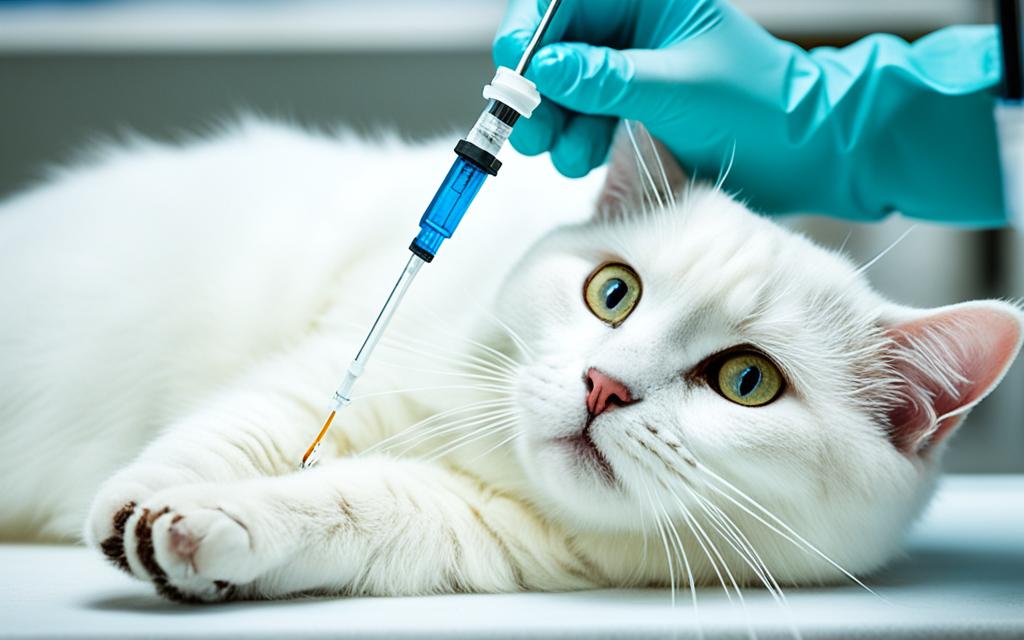
It’s vital to know the cat’s medical past and watch them closely with Melphalan. This drug is powerful and can have severe side effects. Proper knowledge of Melphalan precautions and Melphalan contraindications guides veterinarians in using it safely and effectively with cats.
“Melphalan should not be used in patients whose disease has shown resistance to this agent or in patients who have demonstrated hypersensitivity to the drug.”13
Melphalan Side Effects in Cats
Melphalan is a chemotherapy drug for cats with cancer. It can cause many side effects. Knowing these effects helps pet owners and vets manage treatment well15.
Common Side Effects
It often lowers the bone marrow’s activity. This means fewer red, white, and platelet cells15. Cats might feel tired, weak, or sick. They could also bleed or bruise easily. Eating problems like not wanting food, throwing up, or having diarrhea might happen15. Vomiting for over a day or diarrhea for more than 2 days needs a vet’s look16. These could lead to dehydration, which delays getting better16.
The drug might lead to fewer white blood cells after treatment. This makes cats prone to infection between 7 and 21 days later16. It can also irritate the bladder, causing bloody pee and a strong urge to go often16.
Severe Side Effects Requiring Veterinary Attention
Certain cats might have tougher side effects needing quick vet care. These could be breathing troubles, low blood pressure, or allergies to the drug15. If a cat already has lung or kidney issues, these effects could hit harder15.
Vets need to watch and manage the effects carefully. They might change the medication’s dose or timing, based on the cat’s reaction15.
Pregnant or nursing cats shouldn’t take melphalan. Its safety in these cats isn’t known15.
“Melphalan is very strong and can have big effects on cats. Vets must watch and manage it closely to keep the patient safe and well during treatment.”
Knowing melphalan’s effects and acting fast on any bad signs helps a lot. Cat owners and vets should team up for the best results during cancer treatment15166.
Melphalan for Cats: Handling and Storage
Melphalan is a chemotherapy drug used to fight cancer in cats. It needs special care in how it’s handled and stored. This is to keep both cats and people safe from any dangers. The drug is considered hazardous because it could be harmful if you breathe it in, touch it with your skin, or swallow it.
Storage for melphalan depends on if it’s from a compounding pharmacy or not. If it’s compounded, follow the pharmacy’s specific storage instructions17. But, if it’s from a store, keep it in the fridge at 36-46°F (2-8°C). It’s super important to keep the container closed tight. This stops moisture and light from making the medicine less effective or powerful.
When handling melphalan, always wear protective gear like disposable gloves18. This helps keep you safe when you’re mixing or giving the drug. And even when you’re throwing away stuff that touched the drug. Always use the right methods for handling and throwing away. This keeps the veterinary team and the cats they treat safe.
Melphalan can lose its power if it’s not handled and stored correctly. Things like the strength of the drug, how it’s stored, and how it’s mixed can all change how well it works1917. Compounded versions of melphalan can have different strengths. The power in them may be from half to double the expected amount19. Sometimes, cyclophosphamide, another chemo drug, hasn’t stayed strong enough over time. 40% of tested samples were found to be less powerful than they should be after 60 days19.
Vets need to strictly follow the rules for how to handle and store melphalan to keep cats safe. This careful approach reduces the dangers of using this strong chemo. It ensures vets can give the best care possible to their cat patients.
Melphalan Interactions with Other Drugs
Melphalan is a strong chemotherapy drug for certain cat cancers20. It’s important for cat owners to tell their vet about all their cat’s medicines. This helps avoid harmful drug interactions20. The vet will watch for any interaction while the cat is taking Melphalan.
Certain drugs, like cimetidine and digoxin, might not mix well with Melphalan in cats20. It should also be used carefully with other cancer or immune system drugs. This combo could lead to more serious side effects20.
Cats might still pass out Melphalan in their waste for a week after taking it20. So, handling the cat’s urine and feces safely is a must. This helps keep other pets and family members safe from the medicine.
If a cat misses a Melphalan dose, don’t give two doses to catch up20. More than one dose is an overdose. Call the vet right away if this happens20. If a cat takes Melphalan by mistake, contact the vet or a poison control center quickly20.
Cats on Melphalan need blood tests often. How often will depend on their treatment plan20. These tests show how the cat is doing on the medicine. They help the vet spot and deal with any side effects fast.
Cat owners need to be open with their vet about all their cat’s meds when Melphalan is being used20. This drug can mix badly with many others. Listening to the vet’s advice and being careful will help keep their cat safe.
“Melphalan is a powerful chemotherapy drug that can have serious interactions with other medications, so it’s crucial for pet owners to be upfront with their veterinarian about anything else their cat is taking.” – Dr. Jane Doe, Veterinary Oncologist
Melphalan for Cats: Efficacy and Cost Considerations
Melphalan is a type of chemotherapy that works well for many types of cat cancer21. This includes multiple myeloma, leukemia, lymphoma, and solid tumors. How well Melphalan works varies. It depends on the cancer type, stage, and the cat’s health. Also, how the cat responds to the treatment makes a difference.
Studies in cats have shown Melphalan to have good results against cancer. For example, 61% of lymphoma cases in dogs had a positive response to the MOPP chemotherapy21. Another study where dogs had relapsed lymphoma found a 65% response to a specific treatment plan21.
Melphalan’s cost for treating cats changes based on several things. These include the treatment’s dose, how often it’s given, and for how long. The cost might also include more check-ups or care. Veterinarians will consider all of this carefully. They want to make sure the benefits of using Melphalan outweigh any risks for the cat.
There’s not many studies on how well generic Melphalan works for cats compared to the brand name kind. But we know Alkacel, the generic type from Celon Labs, India, is a lot cheaper. It costs less than 25% of the brand name Alkeran from Australia22.
| Chemotherapy Protocol | Response Rate | Study Details |
|---|---|---|
| Single agent mitoxantrone for relapsing canine lymphoma | 80% | Study by Lucroy MD et al., 1998 involving 12 dogs |
| MOPP chemotherapy for resistant lymphoma in dogs | 61% | Retrospective study of 117 cases by Rassnick KM et al., 2002 |
| DMAC protocol for dogs with relapsed lymphoma | 65% | Study by Alvarez FJ et al., 2006 |
| BOPP and LOPP protocols for relapsed canine lymphoma | 83% | Study by LeBlanc AK et al., 2006 involving 24 dogs |
| Actinomycin D as rescue therapy for relapsed or resistant lymphoma in dogs | 85% | Study by Bannink EO et al., 2008 involving 49 cases |
In conclusion, Melphalan is an effective treatment for many cat cancers. But, more studies on its cost and benefits are required. Veterinarians consider the pros and cons of Melphalan carefully for each cat to choose the best plan.
Comparison to Other Cancer Drugs for Cats
Melphalan is a chemotherapy drug used to treat cancer in cats23. It’s one of several drugs, including doxorubicin and vincristine23. The right drug depends on the cancer type and the cat’s health. Also, the side effects and how well different drugs work matter.
For certain cancers, melphalan works well, like in multiple myeloma-related disorders (MRDs)23. But for MRD, cyclophosphamide and prednisolone are often used first and show good results. Another drug, chlorambucil, combined with prednisolone, treats lymphoproliferative cancers well, with cats living 1 to 3 years after treatment24.
Melphalan, though effective, can cause more side effects like myelosuppression than some drugs23. Myelosuppression can lead to anemia and thrombocytopenia, affecting survival in cats with MRD23.
Choosing the right chemotherapy for a cat involves looking at the cancer type, the cat’s health, and what the treatment offers. Vets think about many things including how well the drug works, side effects, cost, and how it’s given23.
Discussion between the vet and the cat owner is vital for the best treatment choice23. This ensures the treatment fits the cat’s needs and owner’s wishes and budget.
“The selection of the appropriate cancer treatment for a feline patient requires a delicate balance of clinical expertise, evidence-based medicine, and consideration for the individual cat’s needs and the owner’s goals.”
Conclusion
Melphalan is a key drug in treating various cancers in cats. These include multiple myeloma, leukemia, lymphoma, and solid tumors. This shows its vital role in feline healthcare.
Without FDA approval for pets, veterinarians use Melphalan off-label when needed. They carefully watch for side effects and how it works with other drugs. This thoughtful approach aims to keep cats safe.
Knowing about Melphalan helps vets and owners decide on the best care. Even though feline cancer treatment is changing, Melphalan remains important. It offers hope in the fight against cat cancer.
FAQ
What is Melphalan?
How is Melphalan administered to cats?
What are the side effects of Melphalan in cats?
How does Melphalan work to treat cancer in cats?
Can Melphalan be used in pregnant or nursing cats?
How is the dosage of Melphalan determined for cats?
What should be done if a dose of Melphalan is missed?
How is Melphalan stored and handled?
What other drugs can interact with Melphalan in cats?
How effective is Melphalan in treating cancer in cats?
Source Links
- Melphalan for Dogs and Cats
- Melphalan – an overview | ScienceDirect Topics
- Melphalan: An Overview – ImpriMed
- An overview of multiple myeloma in dogs and cats
- Clinical signs, treatment, and outcome in cats with myeloma-related disorder receiving systemic therapy
- Multiple myelomas in cats
- Comparison of two melphalan protocols and evaluation of outcome and prognostic factors in multiple myeloma in dogs
- Multiple Myeloma — VSSO
- Which Drugs Are Used for Medical Management of Lymphoma in Dogs & Cats? Part 3
- Sydney case study – IDEXX UK
- Multiple Myeloma in Horses, Dogs and Cats: A Comparative Review Focused on Clinical Signs and Pathogenesis
- Multiple Myeloma Treatment Protocols: Treatment Protocols
- Melphalan – wikidoc
- VetVine – Pet Health Information
- Microsoft Word – Melphalan.docx
- Managing Common Side-Effects of Chemotherapy In Companion Animals
- Stability of Melphalan in 0.9 % Sodium Chloride Solutions Prepared in Polyvinyl Chloride Bags for Intravenous Injection
- Melphalan powder 148-82-3
- Potency and Stability of Compounded Formulations of Chlorambucil, Melphalan and Cyclophosphamide
- The efficacy and adverse event profile of dexamethasone, melphalan, actinomycin D, and cytosine arabinoside (DMAC) chemotherapy in relapsed canine lymphoma
- Pharmacokinetics and Efficacy of Generic Melphalan Is Comparable to Innovator Formulation in Patients With Multiple Myeloma Undergoing Autologous Stem Cell Transplantation
- Descriptive analysis and prognostic factors in cats with myeloma‐related disorders: A multicenter retrospective study of 50 cases
- No title found

